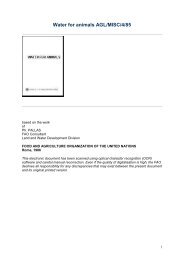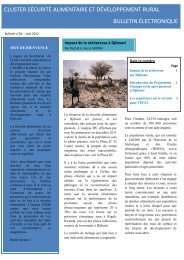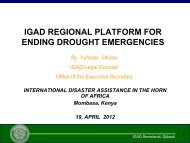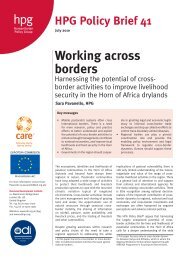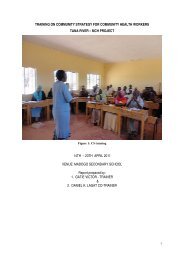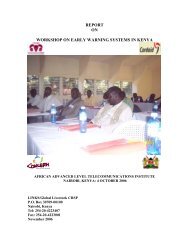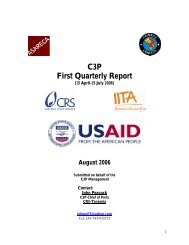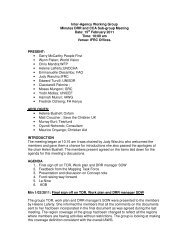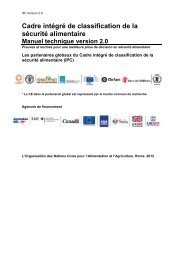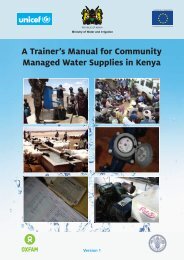Synthesis of Existing Knowledge and Experience on the Provision of ...
Synthesis of Existing Knowledge and Experience on the Provision of ...
Synthesis of Existing Knowledge and Experience on the Provision of ...
Create successful ePaper yourself
Turn your PDF publications into a flip-book with our unique Google optimized e-Paper software.
associated with <strong>the</strong> program include a lack <str<strong>on</strong>g>of</str<strong>on</strong>g> full community participati<strong>on</strong>, c<strong>on</strong>flict <str<strong>on</strong>g>of</str<strong>on</strong>g> interest in <strong>the</strong>proposed project areas, <str<strong>on</strong>g>and</str<strong>on</strong>g> lack <str<strong>on</strong>g>of</str<strong>on</strong>g> support by stakeholders.At <strong>the</strong> same time, <strong>the</strong> Oromia Growth Corridors Plan is also <strong>the</strong> first purely government ledprogram which openly states that most l<str<strong>on</strong>g>and</str<strong>on</strong>g> in Borana z<strong>on</strong>e should be maintained as rangel<str<strong>on</strong>g>and</str<strong>on</strong>g> <str<strong>on</strong>g>and</str<strong>on</strong>g>should not be c<strong>on</strong>verted for agricultural producti<strong>on</strong>. It also recognizes that an integrateddevelopment approach which addresses o<strong>the</strong>r crucial development needs such as access to markets<str<strong>on</strong>g>and</str<strong>on</strong>g> health facilities, am<strong>on</strong>g o<strong>the</strong>r services, are indispensable if livelihoods are to be protected <str<strong>on</strong>g>and</str<strong>on</strong>g>improved.4.2.2 Approaches to water development <str<strong>on</strong>g>and</str<strong>on</strong>g> community engagementAs highlighted in Secti<strong>on</strong> 3, different actors employindependent approaches to water development <str<strong>on</strong>g>and</str<strong>on</strong>g>community engagement, with little interacti<strong>on</strong> orharm<strong>on</strong>izati<strong>on</strong> between <strong>the</strong>m. Approaches rangefrom technocratic, with generic methods <str<strong>on</strong>g>of</str<strong>on</strong>g>promoting participati<strong>on</strong> (<str<strong>on</strong>g>of</str<strong>on</strong>g>ten symbolic), to highlyparticipatory approaches specific to particularlocalities <str<strong>on</strong>g>and</str<strong>on</strong>g> socio-political settings. There is morefocus am<strong>on</strong>g d<strong>on</strong>ors, development organizati<strong>on</strong>s<str<strong>on</strong>g>and</str<strong>on</strong>g> some government programs such as <strong>the</strong> PCDPto rehabilitate existing water points as a costeffective means <str<strong>on</strong>g>of</str<strong>on</strong>g> availing water, <str<strong>on</strong>g>and</str<strong>on</strong>g> also as a wayto avoid disrupting mobility patterns <str<strong>on</strong>g>and</str<strong>on</strong>g>disagreement over new water points. However, <strong>the</strong>majority <str<strong>on</strong>g>of</str<strong>on</strong>g> practiti<strong>on</strong>ers remain focused <strong>on</strong> puttingin place physical infrastructure with little attenti<strong>on</strong>to planning, effective management, operati<strong>on</strong>, <str<strong>on</strong>g>and</str<strong>on</strong>g>sustainability, partially pushed by c<strong>on</strong>siderablepressure to meet targets. This lack <str<strong>on</strong>g>of</str<strong>on</strong>g> coherence inapproach is recognized by all actors as animpediment to sustainable development in <strong>the</strong>rangel<str<strong>on</strong>g>and</str<strong>on</strong>g>s. Highlighted is an example related tocommunity c<strong>on</strong>tributi<strong>on</strong>s (Box 13).Box 13: Same locati<strong>on</strong>, differentapproachesEven though <strong>the</strong>re are synergies between <strong>the</strong>government’s PCDP <str<strong>on</strong>g>and</str<strong>on</strong>g> PSNP programs (whichoverlap in 9 woredas across <strong>the</strong> regi<strong>on</strong>s), <strong>the</strong>reremain fundamental differences in approach tocommunity engagement. The PSNP pays cash forwork <strong>on</strong> public works c<strong>on</strong>structi<strong>on</strong> while <strong>the</strong>PCDP insists <strong>on</strong> a m<str<strong>on</strong>g>and</str<strong>on</strong>g>atory 5% cashc<strong>on</strong>tributi<strong>on</strong> from communities for allinfrastructure developments.Am<strong>on</strong>g NGOs, it has been observed thatcompetiti<strong>on</strong> over d<strong>on</strong>or funds, competiti<strong>on</strong> overcommunity attenti<strong>on</strong> <str<strong>on</strong>g>and</str<strong>on</strong>g> <strong>the</strong> limited number <str<strong>on</strong>g>of</str<strong>on</strong>g>available technical government experts in areaspopulated by multiple NGOs, in additi<strong>on</strong> to weakgovernment oversight all pose a challenge tost<str<strong>on</strong>g>and</str<strong>on</strong>g>ardizing what <str<strong>on</strong>g>and</str<strong>on</strong>g> how much communitiesc<strong>on</strong>tribute to water interventi<strong>on</strong>s. Fur<strong>the</strong>rmore,it is difficult to dem<str<strong>on</strong>g>and</str<strong>on</strong>g> community c<strong>on</strong>tributi<strong>on</strong>sbey<strong>on</strong>d <strong>the</strong> maximum expected by establishedprograms (Behnke et al, 2008). Thus in areaswhere cash for work is <strong>the</strong> comm<strong>on</strong> practice,expecting communities to c<strong>on</strong>tribute m<strong>on</strong>etarilybecomes extremely challenging.However, partnerships <str<strong>on</strong>g>and</str<strong>on</strong>g> dialogue betweendifferent stakeholders are beginning to emerge, indicating cross-fertilizati<strong>on</strong> <str<strong>on</strong>g>of</str<strong>on</strong>g> ideas <str<strong>on</strong>g>and</str<strong>on</strong>g> approachesbetween actors. In SNNPR, <strong>the</strong> head <str<strong>on</strong>g>of</str<strong>on</strong>g> <strong>the</strong> water bureau menti<strong>on</strong>ed that positive resp<strong>on</strong>ses to <strong>the</strong>PCDP’s participatory approach have been observed at grassroots level, <str<strong>on</strong>g>and</str<strong>on</strong>g> mainstream technicalexperts in government are beginning to learn from <str<strong>on</strong>g>and</str<strong>on</strong>g> adopt elements <str<strong>on</strong>g>of</str<strong>on</strong>g> this approach. It is alsoeasy for <strong>the</strong> water bureau to access <str<strong>on</strong>g>and</str<strong>on</strong>g> learn from <strong>the</strong> PCDP, as PCDP project pers<strong>on</strong>nel atregi<strong>on</strong>al level are housed in <strong>the</strong> same complex as <strong>the</strong> water bureau. The PCDP itself, with fundsfrom <strong>the</strong> Japan Development Fund, is now working with eleven NGOs to roll out its approach <str<strong>on</strong>g>and</str<strong>on</strong>g>activities (Belayhun Hailu 56 , pers<strong>on</strong>al communicati<strong>on</strong>).The PSNP is also actively promoting partnerships with NGOs to address capacity shortages withingovernment <str<strong>on</strong>g>and</str<strong>on</strong>g> promote knowledge sharing. There is also dialogue between <strong>the</strong> PSNP <str<strong>on</strong>g>and</str<strong>on</strong>g> PCDPto ir<strong>on</strong> out differences in approaches to community c<strong>on</strong>tributi<strong>on</strong>s (Belayhun Hailu, pers<strong>on</strong>alcommunicati<strong>on</strong>). Fur<strong>the</strong>rmore at regi<strong>on</strong>al level, <strong>the</strong> Oromia Growth Corridors Plan invites NGOs<str<strong>on</strong>g>and</str<strong>on</strong>g> d<strong>on</strong>ors to participate in <strong>the</strong> implementati<strong>on</strong> <str<strong>on</strong>g>of</str<strong>on</strong>g> <strong>the</strong> initiative, <str<strong>on</strong>g>and</str<strong>on</strong>g> regi<strong>on</strong>al implementers are56 Senior Officer - <str<strong>on</strong>g>Knowledge</str<strong>on</strong>g> Management <str<strong>on</strong>g>and</str<strong>on</strong>g> Participatory Learning, PCDP.75



